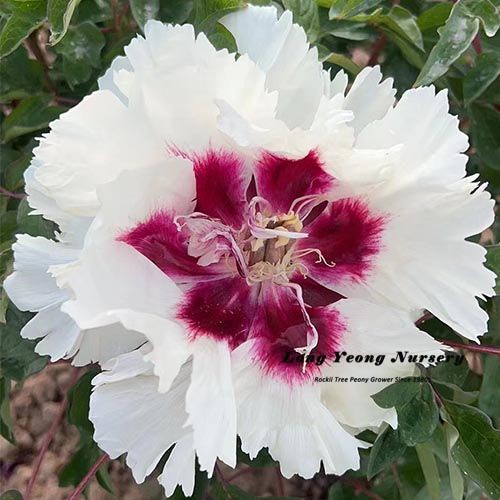
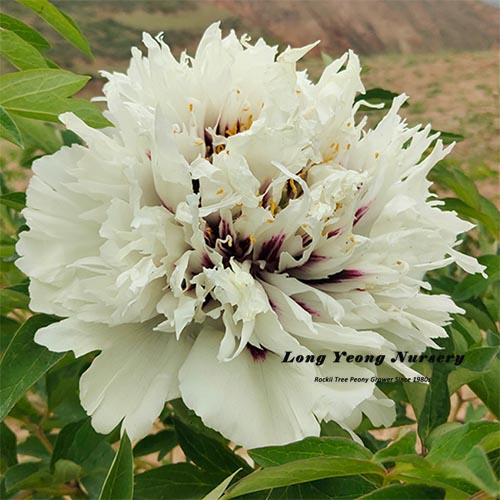


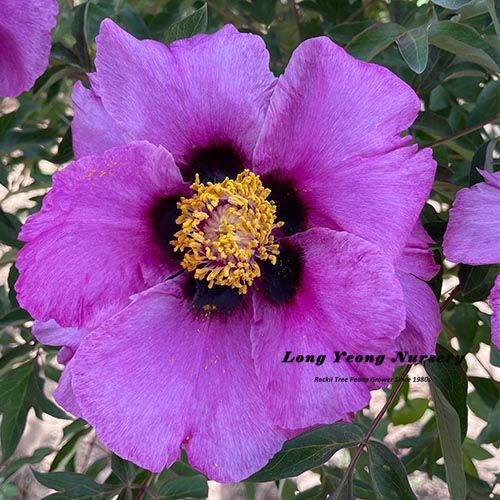
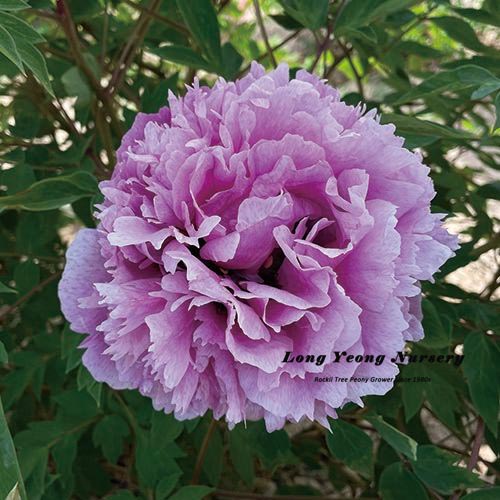

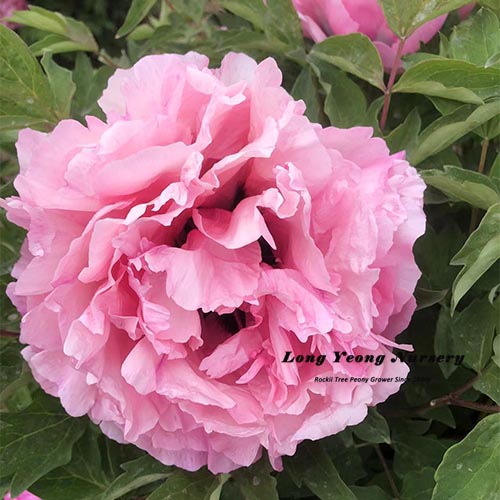

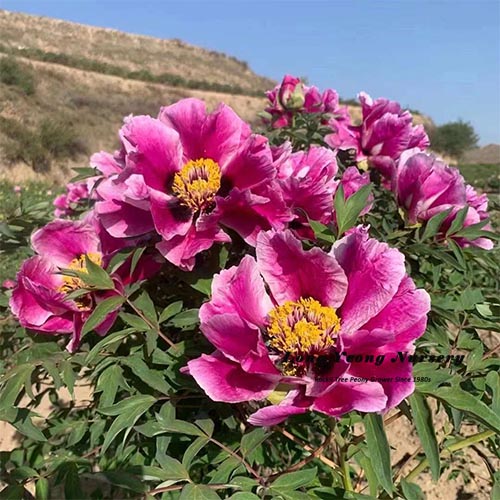

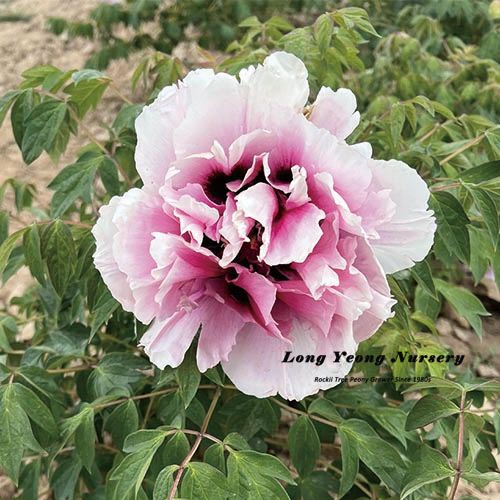
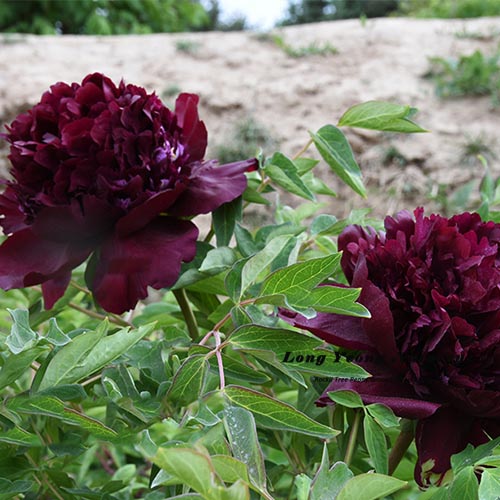
Rockii Tree Paeonia, also known as Rock’s peony or purple spot peony, is named after the unique colour spot at the base of its petals. The wild species can be found in regions such as Gansu, Shaanxi, Henan, and Hubei, while cultivated varieties are mainly concentrated in the ancient Silk Road regions traversed by the Wei River, Tao River, and Daxia River in Gansu. Peony cultivation is prevalent in provinces such as Sichuan, Gansu, Qinghai, Shaanxi, and Ningxia, earning it the additional monikers of Gansu peony or Northwest peony. In Gansu, peony cultivation dates back to the Tang Dynasty in over sixty percent of the counties and cities, making it the most widespread and popular region for Paeonia rockii cultivation.
Rockii Tree Paeonia is a deciduous shrub that can grow up to 3 meters tall with short, stout branches. Its leaves are typically compound, with two to three pairs of leaflets, occasionally having three leaflets near the top of the branch. The terminal leaflet is broadly ovate, measuring 7–8 centimetres in length and 5.5-7 centimetres in width, usually tri-lobed to the middle with slightly lobed or unlobed segments. The upper surface of the leaf is smooth and green, while the lower surface is light green and may have a white powdery coating. It is sparsely covered with short, soft hairs or is nearly hairless. The petiolule of the terminal leaflet is 1.2-3 centimetres long. The lateral leaflets are narrowly ovate or oblong-ovate, measuring 4.5-6.5 centimetres in length and 2.5-4 centimetres in width. They are unevenly 2-3 lobed or unlobed and nearly sessile. The leaf stalk is 5–11 centimetres long, and the stalk and rachis are hairless.
The flowers are located alone at the top of the branches, with a diameter of 10-17 centimetres. The flower stalk measures 4-6 centimetres, and there are five bracts of unequal size. The sepals are green, broadly ovate, and unequal. The petals, which can be broadly ovate and irregularly undulate at the apex, are usually five, but sometimes double, and range in colour from rose, purplish-red, pink to white, measuring 5-8 centimetres in length and 4.2-6 centimeters in width. The stamens are 1-1.7 centimetres long with purple-red or pink filaments, white upperparts, and elliptic anthers. The disk is leathery and cup-shaped, with several sharp teeth or lobes at the top, and it completely envelops the mature pistil, which splits when mature. There are usually five, occasionally more, densely hairy carpels. The oblong follicles are densely covered with yellow-brown rigid hairs. The plant blooms in May, and the fruit ripens in June.
In China, cultivated peonies are typically categorized into four major groups: Central Plains, Northwest, Jiangnan, and Southwest. The Paeonia rockii peony group, also known as the Northwest peony group, is the second-largest group after the Central Plains peony group.
Named after the conspicuous large purple and purple-red spots at the base of its petals, the Gansu rockii tree Paeonia is native to high-altitude areas of Gansu. It survives in remnants of secondary forests at altitudes ranging from 1100 to 3200 meters. These regions experience winter temperatures as low as -86°F, with some areas dropping to -100.4°F, making this variety inherently cold-resistant. Noteworthy advantages of Paeonia rockii are as follows:
- Cold Resistance: Rockii Tree Peony is exceptionally cold-resistant and can endure temperatures as low as -109.4°F. As a result, it is suitable for cultivation in countries such as Canada, Russia, Sweden, Finland, Germany, Norway, and the United States. It is also well-suited for northern regions in China, including Ningxia, Xinjiang, Qinghai, Shaanxi, Tibet, Beijing, Tianjin, Hebei, Shanxi, Inner Mongolia, and Jilin.
- Drought Resistance: Rockii Tree Peony can thrive in regions with as little as 280mm of annual rainfall, and only requires irrigation 2-3 times a year for optimal growth and flowering. In areas with annual rainfall above 400mm, it can grow naturally without artificial irrigation. In regions with annual rainfall exceeding 600mm, Paeonia rockii peony saplings exhibit robust growth.
- Salt and Alkali Tolerance: Adaptable to a wide range of soil types, from slightly acidic to slightly alkaline (pH 5.5-8.2), including sandy and clayey soils. It can grow well on slopes, in ravines, on plateaus, and in sandy areas.
- Tall Plant Stature: Rockii Tree Peony exhibits a tree-like structure with a trunk diameter ranging from 8cm to 20cm and a height of 2m to 4m. The canopy width is 3-4m.
- Intense Fragrance: Paeonia rockii peony emits a fragrance from a single flower that rivals the combined fragrance of ten flowers from the Central Plains peony. Its scent is not only delightful but also believed to have therapeutic properties.
- Slow Aging: Paeonia rockii peony plants age slowly, which allows for the cultivation of ancient peony trees that can live for hundreds or even thousands of years.
Rockii Tree Peony is a unique peony variety that stands out due to its thicker petals, intense fragrance, towering stature, robust growth, strong cold resistance, minimal susceptibility to pests and diseases, longer lifespan, and high medicinal value. This versatile plant can be used in peony gardens, villa landscaping, garden landscapes, and agricultural eco-park development. In addition to its ornamental and medicinal value, Rockii Tree Peony seeds can be pressed to produce edible oil. The petals and stamens can also be used for tea, food, beverages, dried flowers, and extraction of essential oils for cosmetic purposes. Various parts of Paeonia rockii, such as branches, leaves, flowers, and fruits, contain medicinal components like paeonol and paeoniflorin, which can be extracted for medicinal purposes. This offers a sustainable alternative to traditional root harvesting. Additionally, Rockii Tree Peony can be used extensively in afforestation projects for ecological restoration, contributing to the protection of natural environments.
